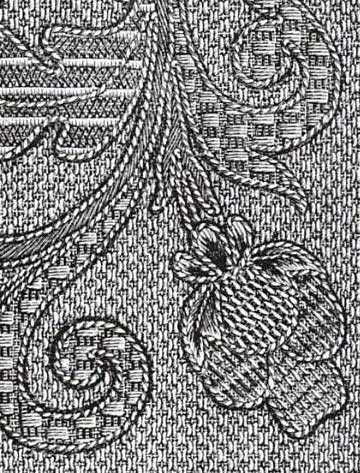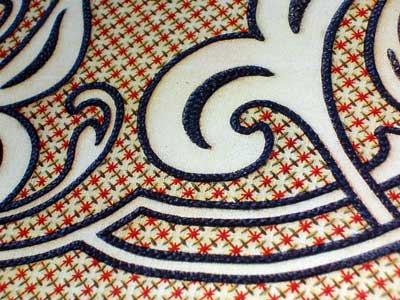Colbert embroidery is an embroidery technique that combines surface embroidery stitches and counted work in one piece of needlework.
It apparently developed in the 19th century, to mimic the embroidered laces (such as Dresden lace) of the century before. It is not so fine as Dresden lace, though – in fact, Colbert embroidery tends to look rather bold and coarse next to the delicate whitework of Dresden lace. And, to boot, Colbert embroidery is usually worked in color.
Colbert embroidery reminds me a lot of the free-form blackwork of the 17th century. Like blackwork from this early era (and unlike most blackwork today), Colbert embroidery is typified by bold lines that make up the predominant design of the piece, while the backgrounds are filled with geometric filling patterns.
Colbert embroidery is not too well-known today – look it up online, and you’ll find only a few resources available, some of which have simplified the look of the technique quite a bit. In fact, in its heyday, the technique was quite elaborate and intricate, as can be seen from the samples that are featured in Therese Dillmont’s Complete Encyclopedia of Needlework.

The photos in Dillmont’s book are black and white, of course, but you can see clearly that Colbert embroidery was a rather “busy” technique. The flowing lines and shapes of flowers, leaves, and so forth were formed by surface stitches or couched braid. Then, within the shapes and over the background fabric, various counted fillings were worked. The technique was used to decorate pillows, mats, and so forth.

The structured, counted filling patterns contrast quite vividly with the flowing lines and curves of the designs. According to Dillmont, Colbert embroidery involves “large designs worked on coarse, transparent material with various filling stitches and braid outlines… The foundation is soft (washed) congress canvas…” and the threads used were actually quite a variety, from cording to stranded and pearl cotton to silk.

Perhaps the best-known book about Colbert Embroidery is the old DMC book by Therese Dillmont. It is in the public domain, and you can find a copy of Colbert Embroidery online through Antique Pattern Library.
Yay for Antique Pattern Library! I love that website!
You can see from the cover of the book that the technique has been somewhat simplified. It’s quite bold and grand, isn’t it?

However, though somewhat simplified compared to the samples in Dillmont’s Encyclopedia, it still reflects the combination of surface stitches in bold designs and geometric background fillings. In the book above, Broderies Colbert, the actual design area is left voided, which makes it somewhat similar to Assisi work.

The voiding of the bold designs is effective, I think. It creates such a stark contrast with the background.
While the book does not go into stitch directions (at all), it does give close up images of different background techniques, which would be a cinch to imitate. The text is in French, dedicated pretty much just to materials lists for the various projects featured in the book – so knowledge of the language isn’t entirely necessary, as most of the supplies are pretty straightforward.

In the back of the book are small line patterns that are suitable for enlargement.
When I saw this technique and started reading a bit about it, I made an immediate connection between it and the book Wessex Stitchery, which I’ve already reviewed.
Wessex Stitchery focuses on a variety of filling techniques – some, admittedly, are probably too busy for Colbert embroidery. But others would serve the technique well, I think.

The photo above is from Wessex Stitchery – and the filling pattern featured there would work for Colbert embroidery, too, I think. The idea of combining Colbert embroidery with Wessex stitchery presents some interesting possibilities.
Colbert embroidery is worked today on Congress cloth, Jobelan or Etamin fabrics – all of which are cotton or blends and resemble canvas more than they resemble fabric. And this means that, in the areas that aren’t stitched, you can see through to whatever is behind the fabric.
I am wondering how the technique would work better on linen; perhaps the weave would have to be looser to accommodate some of the thicker background motifs. I’m also wondering how the technique would work for, say, a monogram, if the monogram were voided (that is, empty of stitching), but outlined with a surface stitch, and then the background were filled with some of the intricate fillings in the Wessex Stitchery book. A good pillow for a gift? A Christmas stocking? Oh, the possibilities…
And isn’t this just the Greatest Thing about embroidery? When it comes to designing or to combining techniques, we really are only limited by our imaginations!
Have you ever tried Colbert embroidery? Do you know of any additional, thorough resources on the technique that you’d like to share with the rest of us? Does this technique appeal to you at all – or do you see any possibilities for combinations or for projects? What are YOUR thoughts?
Thanks for putting up with my ramblings! Have a terrific weekend!







Hi, Mary! Thanks for introducing another embroidery technique! I was wondering… do you sometimes feel like if you don't stitch something EXACTLY the way you learned it, it's just… wrong? Do you mind that? Sometimes I don't mind if the back of a work will look messy – especially if it's going to be appliqued on something else and the back will be hidden forever. So I'm not always extra-carefully on doing things "the right/perfect way". How about you (and our friends reading this 🙂 )?
Very interesting Mary. I had never heard of Colbert embroidery. I have the Complete Encyclopedia of Needlework, but I must have either not read that part or i`ve forgotten. It looks like an interesting tecnique…rather like blackwork on steroids.I would love to experiment with it in black and white…
I have never even heard of many of the techniques that you highlight for us in your blog. But that is what makes your writing unique and enjoyable. Thanks for another wonderful review. I am going to read up all I can on this technique over the weekend.
I like the patterns and colors in the Broderies Colbert book you bought, but they appear to be a different animal than the technique shown in Dillmont's book. I'm not sure I could stand to leave the voided area unworked! I would be tempted to try pulled work in those areas, though that might be too busy.
The line drawings of the Colbert embroidery in Dillmont's book make me think of goldwork. I wonder how those motifs would looks stitched in silk and metal? Or at least metallic threads like Kreinik.
Mary thanks so much for the info on "Colbert"…..just when I thought there was nothing "new under the sun" in embroidery. I LOVE the variation in textures….I'm ALWAYS looking for that…one of the reasons cross stitch is my least favorite stitching. But THIS looks absolutely "Intriguing"…I've GOT to get that book….as usual, I let you be my primary filtering agent for anything new, then I take it from there…er..I mean… "You"..Thanks Again….Judy in Pittsburgh
I've made a little needlebook, a gift for a friend in Colbert Embroidery. You can see it in my photo album, here: http://perso.bellapix.com/silvgar1 , in "Ricamo", the last photo, n° 62.
Silvia, from Italy
I have seen the old DMC Colbert book and thought that it was an interesting technique and I, too, was reminded of Assisi work.
I think your idea of combining Colbert and Wessex is intriguing. Do it! 🙂
Comment to Samanta:
I think it's good to know the 'correct' way to do something, but I also think that if you have found a different way that works for you don't let the 'correct' way stop you. On the flip side if you have the opportunity to take a class in a technique that interests you, do it! You never know what tips or tricks you might pick up.
The only thing that truly matters to me when it comes to embroidery is 'how does the finished piece look?'. If it looks good does it really matter how it was done? If it doesn't look good it doesn't much matter if the technique was 'correct'. (There are many levels of grey so don't take this as a black and white statement. 🙂
I will say that sometimes learning the 'correct' way can be easier than being self-taught.
Haven't seen this style before but wondered, since I'm waiting for a beginners book on drawn thread, how this would work done on multiple layers of cloth. The top layer would have the background stitches, with the bound cutwork areas, while the lower layer(s) could have details, different cloth and/or different colors.
Not sure if that would be too busy, but might try something like it when the books arrive.
Oh My God!!! More ideas! It looks like being a wonderful idea combining Colbert with Wessex embroidery – so many ideas… most of them will be just only ideas.
I've read about Colbert embroidery just in one of Therese Dillmont's books, I think, but looking at the pictures I think I'll never managed doing such an intricate embroidery!
Oh, so beautiful!
Another new (to me) technique. Sigh, I'll never live long enough…
Mary I had just found the DMC & was wondering if there were any other notes on Colbert embroidery,when I found you [again].Thanx for introducing Wessex Embroidery. When I saw it I thought of Composite stitches that are used for the Ground/filling.I also agree with you that All Stitches/embroidery are those that have been handed down to us. I firstheard about Colbert From The Mary Thomas, from her “Teach Yourself Embroidery” book.Yes I also have The Encyclopaedia By Dillmont,which gives us only in black7 white so we ‘re not able to see the distinctcontrast that Colour gives.
Hi Mary,
thank you so much for all theses articles, you became my source for embroidery.
Stunning work
this Colbert emb. reminds me of “zendangles” drawn in papercraft.
Dear Mary, I read your text about Colbert embroidery with great interest. I would like to ask you where I can find more photos and explanations of the black and white designs. I can’t really find anything in Dillmont’s encyclopedia. I have the 1945 edition in my possession. This is a lot different than the old designs
Kind regards , Sary.